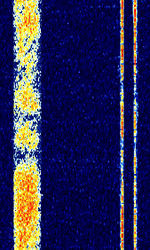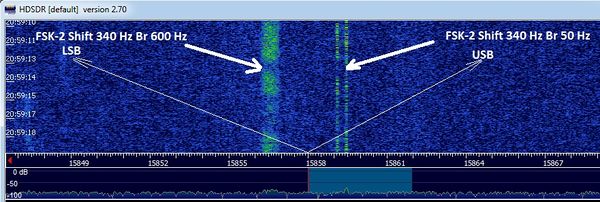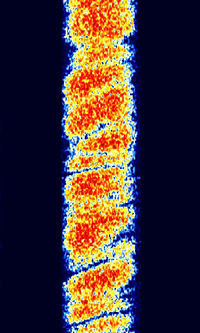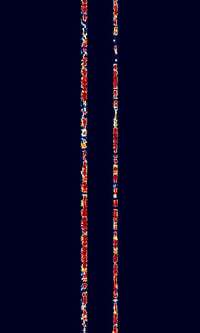Modernised High Frequency Communications System (MHFCS)
The Modernised High Frequency Communications System (MHFCS) is an Australian Department of Defense HFHigh Frequency (3-30 MHz) System for their military communications network. Also known as AUS MIL ISBIndependent Side Band Modulation Modem, AUS MHFCS, and ADF MHFCS. This system was initiated as the High Frequency Modernization Project.
The purpose of the High Frequency (HFHigh Frequency (3-30 MHz)) Modernisation Project (JP 2043) is to "provide the Australian Defense Forces (ADF) with a secure, cost-effective information exchange capability for the command and control of deployed forces as a primary survivable system and as a parallel system to satellite communications".
Characteristics[edit]
As reported in the November 8 2018 logs in the UDXF by Eddy Walters of Australia, Australian Defence Force have changed their previous dual channel system to two single channel with 4 kHzKiloHertz (kHz) 10^3 Hz spacings. The lower of the 2 frequencies has a speed of 600 baudBaud (unit symbol Bd) is the unit for symbol rate or modulation rate in symbols per second., while the higher is 50 baudBaud (unit symbol Bd) is the unit for symbol rate or modulation rate in symbols per second.. The shift in both cases in 850 HzHertz (Hz), unit of frequency, defined as one cycle per second (1 Hz)..
Previously, MHFCS's normal mode of operation is USBUpper Side Band Modulation (Radio, referring to reception and modulation mode)Universal Serial Bus (Computer, referring to USB Ports and cables) voice channels for use with the Australian Defense Force, primarily on the Voice Contact Nets (VCN). MHFCS also has digital modes used for sending encrypted data. Apart from ALEAutomatic Link Establishment and ANDVT, the digital mode used in this system is an ISBIndependent Side Band Modulation modulated FSKFrequency-Shift Keying mode. ISBIndependent Side Band Modulation (Independent Sideband Modulation) is when a signal modulates two independent sidebands, a USBUpper Side Band Modulation (Radio, referring to reception and modulation mode)Universal Serial Bus (Computer, referring to USB Ports and cables) and an LSBLower Side Band Modulation, that is independent of each other. This allows one type of signal on one sideband, and another type on the other sideband.
In ISBIndependent Side Band Modulation mode, this system has been seen transmitting a pair of signals together. One 340Hz shift 600bd FSKFrequency-Shift Keying on LSBLower Side Band Modulation, and 340Hz shift 50bd FSKFrequency-Shift Keying on USBUpper Side Band Modulation (Radio, referring to reception and modulation mode)Universal Serial Bus (Computer, referring to USB Ports and cables). The 600Bd signal has roughly 750 HzHertz (Hz), unit of frequency, defined as one cycle per second (1 Hz). of bandwidth, where the 50Bd signal has about 400Hz of bandwidth. The total bandwidth given the two independent signals would be ~3.4 kHzKiloHertz (kHz) 10^3 Hz, which includes the space between the two FSKFrequency-Shift Keying signals. The shift between the two FSKFrequency-Shift Keying signals is about 2750 HzHertz (Hz), unit of frequency, defined as one cycle per second (1 Hz)..
The 2 sidebands evidently have names, per Eddy Walters. The USBUpper Side Band Modulation (Radio, referring to reception and modulation mode)Universal Serial Bus (Computer, referring to USB Ports and cables) side is called Rockwell 700B while the LSBLower Side Band Modulation is called Rockwell CPU100. The actual significance of these names remains a mystery.
Images made by KarapuZ.
Samples[edit]
| FSKFrequency-Shift Keying 340Hz 600Bd | FSKFrequency-Shift Keying 340Hz 50Bd |
|---|---|
| |
|
Frequencies[edit]
The list of allotted frequencies can be found here.
Decoding Software[edit]
Video Examples[edit]
Additional Images[edit]
Additional Links[edit]
- Shortwave Listeners Delight: MHFCS
- Vic Radio Zone info on ADF-HFCS [dead link]
- Australian Defense Force HF Systems Info
- RadioScanner.RU MHFCS Signal Id, KarapuZ
- Hinet Australian 600Bd FSK [dead link]
- Australian Govt Report on MHFCS Project [dead link]
- I-56578 Australian MHFCS [dead link]




